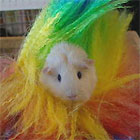Breed: Cavy (Guinea Pig)
Temperament: quiet and manageable
Cost: $5-$45
Lifespan: up to 11 years, average 4-5 years
Maintenance: medium
Recommended for: first time pet owners, small residences Cavies are a great way to introduce new pet owners to the responsibilities of pet ownership. They’re cheap and pretty easy to care for too. History Most people know them as guinea pigs although they are also often called cavies (Cavy porcellus). Cavies are rodents native to South America, where they still exist in the wild today and where domestication first started; not so much as a pet but rather as a food source. Cavies still form a substantial part of the Andean culture’s diet today. Appearance Cavies come in a multitude of colours such as white, black, red, gold, buff (biscuit colour), cream, lilac, slate, chocolate and saffron. A ‘self’ is any plain solid colour with matching coloured pigment. The coat types have four main variations: Shorthair – covering a range of colours, markings and crests. Coarse-coats – the coat stands away from the body, such as the Rex. Unlike a rex cat, the coat is wiry. These look a little like a Koala, with hair much like steel wool. Another example is the Abyssinian. Again, unlike an Abyssinian cat, the cavy coat has a number of rosette-like crests in a number of patterns. Sometimes described as toilet brush but more often called ‘whirligigs’ by breeders. Longhairs – a long coat, which can grow about one inch per month. Satin – the coat has a shiny appearance due to hollow hair follicles. In addition to these coat types, there are additional groups that help describe the variations in the coat. These are: Crested – a small crest is evident on the head. Ticked – the hair has a base colour with silver tips at the ends of the hair. Marked – a patterned coat with more than one colour. These coat types may be combined with any of the colours. Temperament As with all rodents, temperament largely depends on how the animal is handled. Those that are well-handled are more inclined to be placid. Infrequently handled cavies are not. You can keep one cavy on its own, but it will need plenty of attention, otherwise it will become solitary. They are social animals and appreciate attention from their owners. Both males (called boars) and females (called sows) are easily handled, however males may be inclined to fight if kept together after having been mated. Females in particular can fight with each other when in heat. Although rabbits and cavies socialise well together, it is important not to keep them in the same hutch. Their individual diets and difference in size make them incompatible house mates. Feeding Rabbit or guinea pig pellets are available at good pet stores. Water must always be available and will stay cleaner if supplied in a gravity feed bottle, but a heavy dish will suffice. Guinea pigs need fresh, clean, unsprayed grass every day to supply vitamin C which the body cannot store. An alternative to grass is hay or lucerne. Supplement the diet with varied vegetables and fruits. Health and lifespan Cavies are susceptible to extremes of heat and cold. They should be sheltered from temperatures above 30



